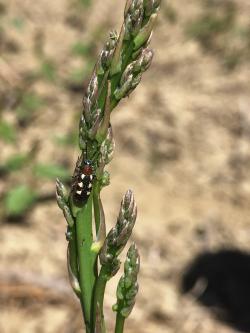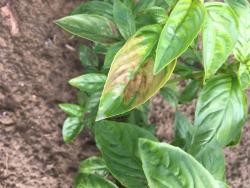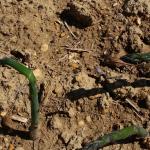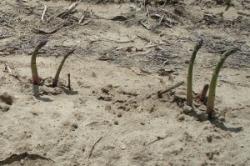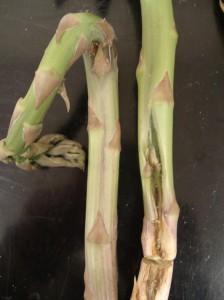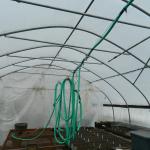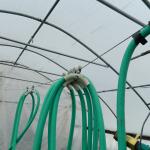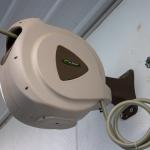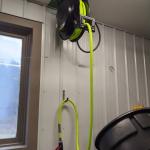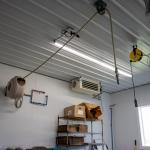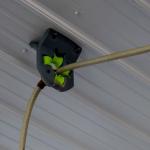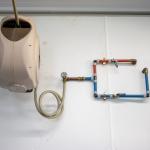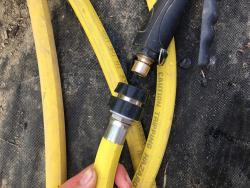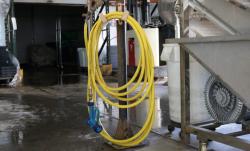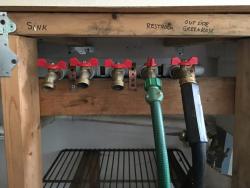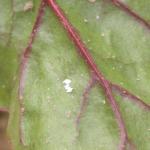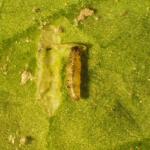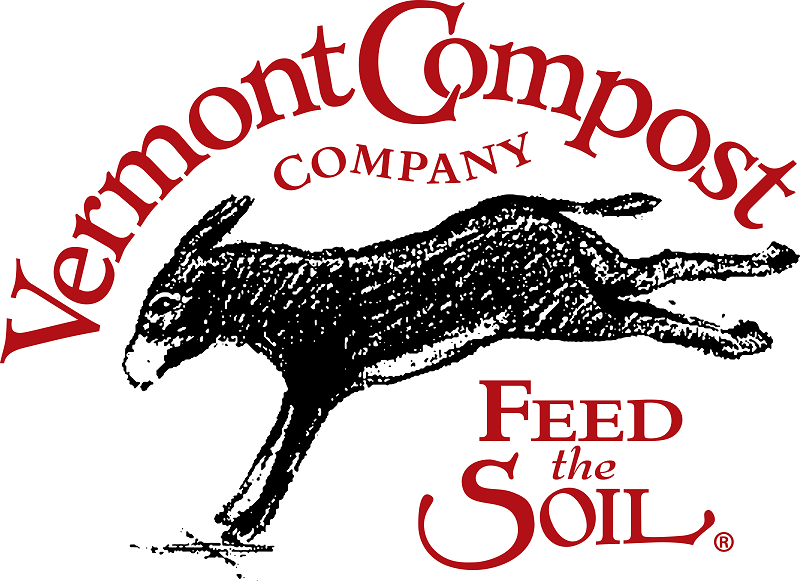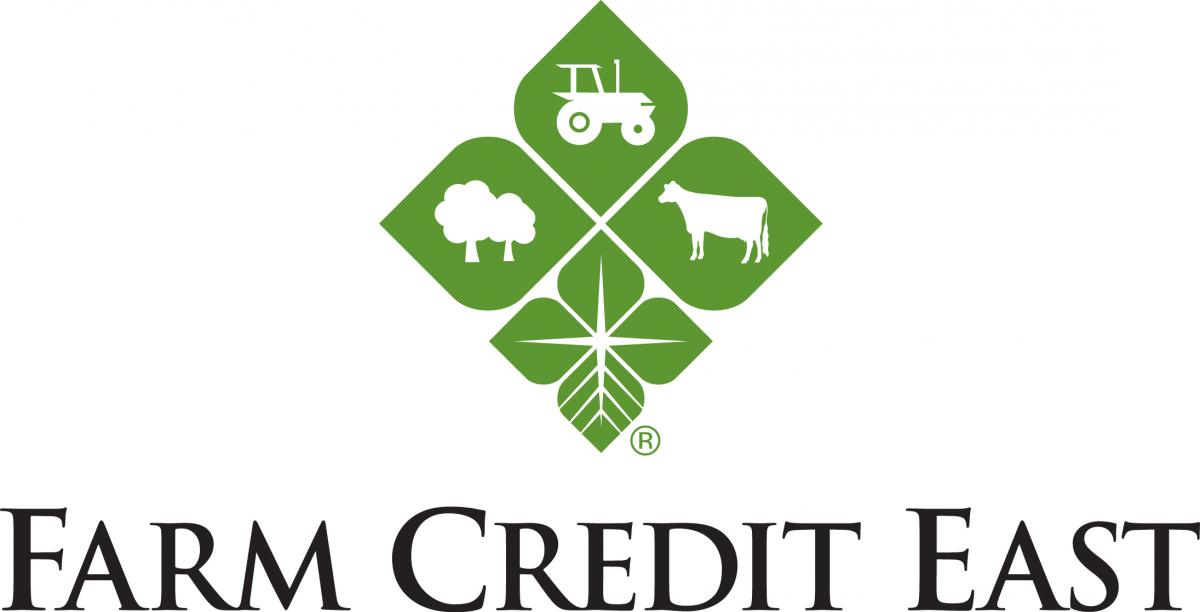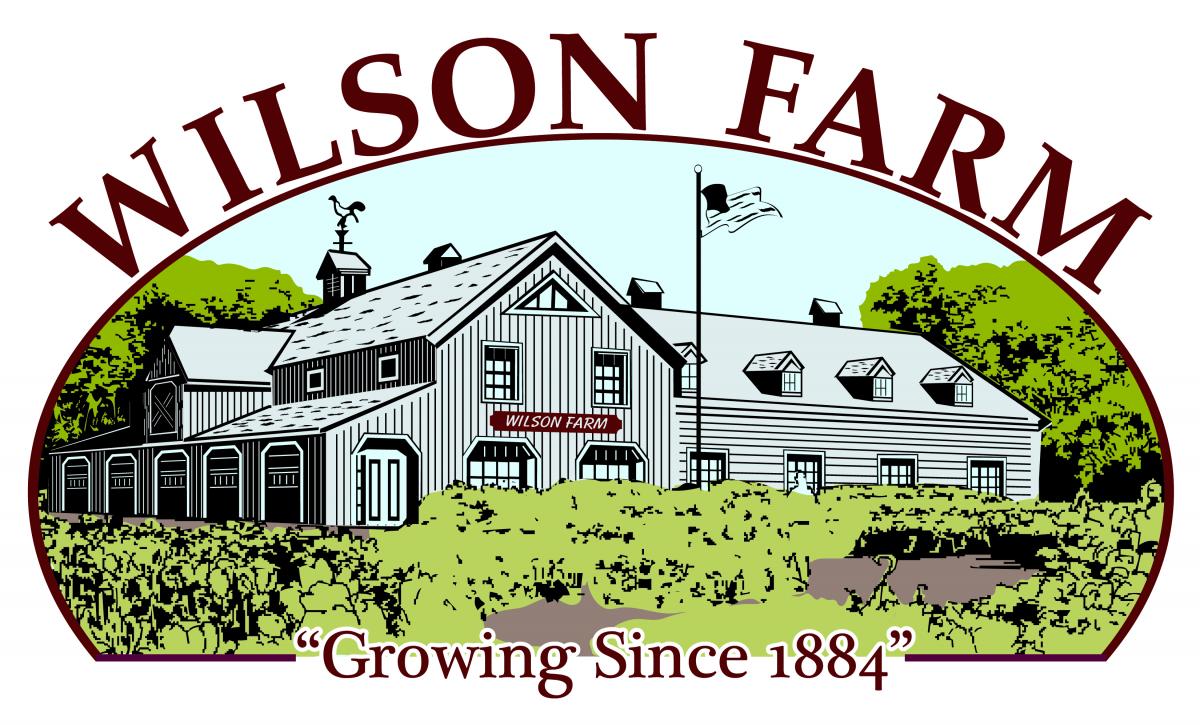To print this issue, either press CTRL/CMD + P or right click on the page and choose Print from the pop-up menu.
Click on images to enlarge.

Crop Conditions
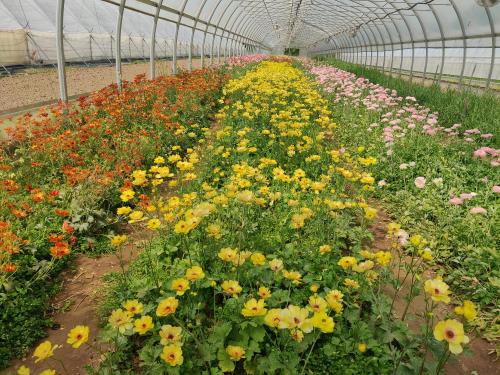 It’s been good weather out there for transplanting, though the sun has been persistently shy. When it does come out, tender transplants might not be ready for it! Plants that are tightly crowded into transplant trays and grown under cloudy conditions and then suddenly exposed to full sun in the field may suffer from sun scald. Be sure to harden-off transplants to give them their best chance, space them out in cold frames if possible, take care to minimize root injury during transplanting, and make sure roots make good contact with the soil. Warm-season crops including tomatoes grow best when soil temperatures are at least 60°F. If soils are too cool, plants will shut down and have little root growth, making them more susceptible to damage when the sun comes out. Black plastic mulch can help heat the soil up but can also get hot itself and burn the stems of tender plants. Make sure planting holes are big enough that they don’t contact stems and consider cooling the plastic by watering the holes or overhead irrigating or applying kaolin clay in a strip along the planting holes.
It’s been good weather out there for transplanting, though the sun has been persistently shy. When it does come out, tender transplants might not be ready for it! Plants that are tightly crowded into transplant trays and grown under cloudy conditions and then suddenly exposed to full sun in the field may suffer from sun scald. Be sure to harden-off transplants to give them their best chance, space them out in cold frames if possible, take care to minimize root injury during transplanting, and make sure roots make good contact with the soil. Warm-season crops including tomatoes grow best when soil temperatures are at least 60°F. If soils are too cool, plants will shut down and have little root growth, making them more susceptible to damage when the sun comes out. Black plastic mulch can help heat the soil up but can also get hot itself and burn the stems of tender plants. Make sure planting holes are big enough that they don’t contact stems and consider cooling the plastic by watering the holes or overhead irrigating or applying kaolin clay in a strip along the planting holes.
We’ve got a great line-up of events planned for this summer—see the Events section at the end of this issue. The first is a twilight meeting on June 12 at Tangerini’s Farm in Millis, MA where farmer Steve Chiarizio will talk about the farm’s new tile drainage and bioreactor system, and our own Maria Gannett and Sue Scheufele will talk about sweet corn weed and insect pest management. SEMAP is co-hosting this one and is offering free, onsite childcare for the evening! We’ll also have food, so please pre-register here so we know how much food to buy and whether you’ll have kids in tow.
Pest Alerts
Alliums
Onion maggots are beginning to emerge across the state this week. Onion maggot pressure tends to vary by location—some farms struggle with it in some fields, and others don’t. If you have a history of this pest on your farm, plants should be covered with netting or row cover during this spring flight and can be removed once the flight ends, after about 3 weeks. Crop rotation is key to managing this pest as there are few labeled pesticides.
Asparagus
Asparagus beetles are active now, feeding and laying eggs on spears. The presence of eggs, larvae, and feeding damage renders crops unmarketable, and 2nd generation feeding damage in ferns can reduce the plant’s ability to build resources for a strong crop the following spring. Most growers avoid chemical treatment during harvest because preharvest intervals interfere with daily harvesting. Pesticide treatment of ferns postharvest is warranted if 50-75% of plants are infested. See the asparagus insect control section of the New England Vegetable Management Guide for labeled materials.
Basil
Basil downy mildew was reported by a grower in Maine this week, on purchased ‘Everleaf’ basil transplants. Basil downy mildew does not overwinter outdoors in the Northeast, but it does overwinter in southern states and can be carried northward on transplants. This is very early for the first report of BDM in the Northeast. Inspect transplants upon receiving and look for symptoms of BDM including yellowing that does not cross leaf veins, with corresponding gray sporulation on the undersides of the leaves. Sunscald notoriously looks like BDM and is common in basil that is planted out in cloudy weather and is then exposed to hot sunny conditions. Sunscald will appear in a V-shaped pattern, as younger leaves shade the leaves below them (see photo). The underside of sun-scalded basil leaves will appear gray, but they will not be fuzzy. Please report any suspected BDM to us at umassveg@umass.edu or 413-577-3976 so we can track this important disease.
Brassicas
 Flea beetles are actively feeding in brassica crops now, causing pinhole damage that will expand into larger holes as leaves grow. Flea beetles prefer non-waxy brassicas (e.g. arugula, mustard, bok choy) but will also feed on young waxy brassica transplants (e.g. broccoli, cauliflower, cabbage). There are several generations of flea beetles every year, but generations overlap, so generally, once they emerge in the spring, they are present and must be managed until fall. Protect young transplants with row cover, kaolin clay (e.g. Surround), or an insecticide. Non-waxy brassica crops can be planted alongside waxy brassicas and sprayed regularly to function as a trap crop and help reduce sprays to the beetles’ less preferred crops. Labeled pesticides include pyrethroids (e.g. Fastac, Baythroid, Brigade, Asana, Danitol, Declare, Warrior, Pounce, Mustang), neonicotinoids (e.g. Venom, Admire Pro, Actara, Platinum) , spinosyns e.g. Radiant (group 5), and Torac (group 21A). Some diamides are also labeled (Exirel, Harvanta, or Verimark for soil applications)—they have long residuals and will also control caterpillars, cabbage root maggot, and cabbage aphid. Spinosad (e.g. Entrust) is the most effective OMRI-listed product. Use a spreader-sticker to help spray solution stick onto waxy brassica leaves.
Flea beetles are actively feeding in brassica crops now, causing pinhole damage that will expand into larger holes as leaves grow. Flea beetles prefer non-waxy brassicas (e.g. arugula, mustard, bok choy) but will also feed on young waxy brassica transplants (e.g. broccoli, cauliflower, cabbage). There are several generations of flea beetles every year, but generations overlap, so generally, once they emerge in the spring, they are present and must be managed until fall. Protect young transplants with row cover, kaolin clay (e.g. Surround), or an insecticide. Non-waxy brassica crops can be planted alongside waxy brassicas and sprayed regularly to function as a trap crop and help reduce sprays to the beetles’ less preferred crops. Labeled pesticides include pyrethroids (e.g. Fastac, Baythroid, Brigade, Asana, Danitol, Declare, Warrior, Pounce, Mustang), neonicotinoids (e.g. Venom, Admire Pro, Actara, Platinum) , spinosyns e.g. Radiant (group 5), and Torac (group 21A). Some diamides are also labeled (Exirel, Harvanta, or Verimark for soil applications)—they have long residuals and will also control caterpillars, cabbage root maggot, and cabbage aphid. Spinosad (e.g. Entrust) is the most effective OMRI-listed product. Use a spreader-sticker to help spray solution stick onto waxy brassica leaves.
Chenopods
Spinach leafminer eggs were reported in Hampshire Co. last week, just around the time we expect to start seeing them based on historical scouting data. You can access our calendar of expected pest emergence here: pdf version, Google calendar version. See the article in this issue for photos and more information on spinach leafminer biology and management.
Peas
Poor stand establishment caused by root rot pathogens has been reported this spring. Peas are very susceptible to several fungi and oomycetes that contribute to this condition, and in cool and gray weather, slow germination and growth exacerbate the issue. To avoid root rot and establishment issues, many growers have moved to transplanting, especially in paper pot systems that make it a little more efficient. Still others have gone to growing peas in tunnels to get an early and quintessentially spring crop to market, but unfortunately while some problems may be solved, others are created. This week growers reported severe Botrytis gray mold—the same gray mold that affects tomatoes in the tunnel, as well as strawberry fruit—growing on leaves, stems, and tendrils. Gray mold thrives in humid conditions. Heating and venting is the best way to dry things out in a tunnel. If that isn’t possible, open up louvers, roll-up sides, and ridge vents, and crank the fans. Removing badly affected plant tissue can also help reduce the source of inoculum.
Sweet corn
Pheromone traps for corn caterpillar pests are going up this week. In some places, traps are up before the corn since we want to be sure to capture the earliest emerging moths. We will report trap captures in Pest Alerts weekly as soon as traps are up at the reporting sites. For European corn borer, trap counts will tell us when ECB adults are emerging from crop residues and when to start scouting fields for caterpillars. ECB scouting results will inform spray schedules. Later in the season, corn earworm trap counts generally inform the spray schedules published in Veg Notes, once they rise above a certain number.
Multiple/Miscellaneous Crops
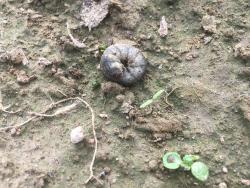 Black cutworm moths are flying now. Cutworm moths will lay eggs on a wide variety of plants, preferring low-lying areas, areas that flood frequently, and fields with lots of crop residue. The caterpillars are active at night and hide in the soil during the day. They often cut plants at the base and pull them underground to feed, resulting in mysterious, missing plants in the morning. Preventative pesticide treatments are not recommended because it’s hard to predict which fields will have heavy cutworm infestations in a given year. Pesticide use should instead be based on scouting results, and pheromone trapping can inform when to begin scouting. Treatment is warranted when 1-2% (pepper and tomato) or 5% (sweet corn) of plants have been cut down. See our Cutworm Damage in Vegetable Crops article in the June 29, 2023 issue of Veg Notes for more information on management and trapping.
Black cutworm moths are flying now. Cutworm moths will lay eggs on a wide variety of plants, preferring low-lying areas, areas that flood frequently, and fields with lots of crop residue. The caterpillars are active at night and hide in the soil during the day. They often cut plants at the base and pull them underground to feed, resulting in mysterious, missing plants in the morning. Preventative pesticide treatments are not recommended because it’s hard to predict which fields will have heavy cutworm infestations in a given year. Pesticide use should instead be based on scouting results, and pheromone trapping can inform when to begin scouting. Treatment is warranted when 1-2% (pepper and tomato) or 5% (sweet corn) of plants have been cut down. See our Cutworm Damage in Vegetable Crops article in the June 29, 2023 issue of Veg Notes for more information on management and trapping.
Contact Us
Contact the UMass Extension Vegetable Program with your farm-related questions, any time of the year. We always do our best to respond to all inquiries.
Vegetable Program: 413-577-3976, umassveg@umass.edu
Staff Directory: https://ag.umass.edu/vegetable/faculty-staff
Home Gardeners: Please contact the UMass GreenInfo Help Line with home gardening and homesteading questions, at greeninfo@umext.umass.edu.
Diagnosing Spear Injury in Asparagus
--Written by Andy Wyenandt, Extension Specialist in Vegetable Pathology, Rutgers Cooperative Extension. Originally published in Rutgers Plant & Pest Advisory, May 11, 2024.
Spear damage in asparagus can be caused by diseases such as Phytophthora spear and crown rot and purple spot. However, other environmental factors during the spring can damage spears as they emerge from the soil.
Freeze Injury
A few weeks ago, temperatures dipped well below freezing for a night or two, and combined with the higher than normal temperature this spring, some asparagus fields that had already started to produce spears were hit with injury. Affected spears will be bent/distorted and begin to breakdown and rot (Fig. 1a).
Cutting frozen spears will show the discoloration of the spear caused by the freeze (Fig. 1b).
Wind
Periods of heavy winds during emergence will cause spears to bend. High winds can cause one side of the spear to dry out quicker than the other causing the spear to bend and point in the direction of the prevailing wind. An asparagus planting is suffering from wind damage if most of the bent spear heads in the bed are pointing in the same direction (Fig.2).
Stones/Rocky Soils
Asparagus grown in stony/rocky soils can suffer mechanical damage as spears emerge from the soil. Stones can cause mechanical abrasions on spears damaging epidermal cell layers as spears emerge from the soil. Spears with mechanical injury such as this will become bent or contorted with severe bends and may also develop loops as the side of the spear that was undamaged continues to develop (Fig. 3).
Other Causes
Spear damage can also result from feeding injury caused by cutworms, slugs and other insects. Insect feeding on one side of the spear will reduce the growth rate on the damaged side and causes spears to curve as the healthy side of the spear continues to develop. Occasionally curved or misshapen spears are observed with no apparent mechanical injury, insect feeding or disease. This damage may be due to unseen injury to the crown by cutting knives, crown rotting pathogens, or environmental stress such as overcutting (Fig.4).
--Written by Chris Callahan, UVM Extension. Originally published on the UVM Extension Ag Engineering blog, 11/16/2018. http://go.uvm.edu/hoses
Having water when and where you need it can make a big difference in vegetable wash station efficiency. Planning for multiple “drops” or spigots around the wash area can make it more convenient to access water where it is needed. Investing in a hose hanger, hose reel or a trolley can help keep the hose off the ground, resulting in a cleaner and safer work environment.
It can be helpful to consider the routing of the supply lines to avoid condensation dripping on people, food contact surfaces, and produce. Cold water flowing through the lines on a warm humid day can result in condensation of water that can drip from the lines. Running the lines away from walkways and produce areas can avoid this being a problem. Running the lines down low in wash areas can also help keep any condensation exposure to a minimum.
Hose Hangers
Hose hangers are the simplest hose management tool to install. These are simply wall mounted or free-standing rounded shelves or manually wound reels that accommodate a coiled hose when not in use. They are generally available from the hardware store, though some growers suggest “buying up” to get a heavy-duty version that will last in an environment where they are used daily. Molded plastic hangers are common for household use but are prone to cracking and breaking. Metal hangers are available and are likely better suited to regular use in a vegetable wash/pack area.
Yard Butler Hanger, $30 from Zoro
Liberty Wall Mount Hanger, $13 from Zoro
Hose Trolleys
Hose trolleys have been in use in greenhouses and propagation houses for some time. These are generally made up of a multi-strand metal wire with pulleys (similar to a dog run). Multiple pulleys have hangers below them to hold sections of hose. The hose expands out when needed and contracts back in an accordion fashion for storage. Trolleys can be made using materials from the local hardware store (metal wire, pulleys, PVC pipe or hose split lengthwise to support the hose, and some zip ties.) Several vendors offer hose trolley kits as well (e.g. FarmTek, Johnny’s).
Hose Reels
Hose reels provide a spring-loaded retraction reel that rolls the hose up neatly after use. These can be ceiling or wall mounted depending on your space and need. Some growers find it helpful to have one mounted under a counter or sink. The reels come in different hose lengths and different hose diameters. Two popular options are available from Equip and Hannay.
Hose Nozzles
Standard, inexpensive hose nozzles work well, but may not hold up to excessive use on a vegetable farm. If you are looking to upgrade to a more durable, and versatile hose nozzle consider upgrading to a “high-pressure wash down gun,” sometimes referred to as the “big blue gun.” This can be found at Johnny’s under their tools section.
Quick Connects
Quick connects may be useful if you find yourself frequently switching out watering wands and spray nozzles or moving hoses from one location to another. They seal tight, and do not require tools or threading connections so they can really speed up switching between tasks. These fittings also provide a swivel which makes moving around the hose during use a bit easier.
Heavy Duty Hoses
Investing in a high-quality hose makes sense when being used every day for business. An inexpensive garden hose is fine for watering the lawn. However, if reliability and durability is needed for dependable irrigation or post-harvest wash down a high-quality hose is worth the investment. EPDM Rubber hoses are long lasting, flexible, and resist kinking. The fittings on the ends of higher quality hoses will hold up better with prolonged use and abuse as well. A common example is the Dramm Colorstorm Premium Rubber Hose Series. These hoses can be found from most greenhouse and horticulture supply companies or commercial suppliers.
Headers & Manifolds
Supply lines into the packshed are most likely only a 1″ supply, so headers don’t need to be any larger than that, and 3/4″ hoses would also work well before branching to multiple different hose drops divided by various splitters. You can make your own header using off the shelf plumbing and valves. PVC valves may provide a larger handle than some prefabricated manifolds which is helpful for regular use. When selecting splitters or building a manifold consider its location and who is using it. Plastic adapters may not be as durable as a metal fitting.
Leafminers on Spinach, Swiss Chard, and Beets
Spinach and beet leafminers are two closely related species of early-season pests that cause damage to early greens. Leafminer eggs were reported in MA last week. These pests attack crops and weeds in the plant family Chenopodiaceae, which includes chard, beets, and spinach as well as several weed species including lambsquarters. The two fly species are very similar and have overlapping hosts. However, beet leafminers prefer laying eggs on beet leaves and spinach leafminer may also cause damage in solanaceous crops such as peppers.
Life cycle
Crop damage is caused by the fly larva burrowing and feeding between the upper and lower epidermis of the leaf. Early damage is a slender, winding ‘mine’ or tunnel, but as the larva grows, these expand and become blotches on the leaves. The fly overwinters as a pupa in the soil and emerges in mid-May. The adult—a small, slender, gray fly 5-7 mm long—lays eggs on the undersides of host leaves. The small (<1 mm), oblong, white eggs, are laid in neat rows on the underside of the leaves and hatch in 3-6 days. They are surprisingly easy to spot if you look under the leaves. If you find tunnels, peeling the outer layer of the leaf will reveal one or several pale, white maggots. When fully grown, maggots usually drop into the soil to pupate, though they may also pupate inside the leaf. The entire life cycle is 30-40 days and there are 3-4 generations per season. Peak activity periods typically include mid- to late May, late June and mid-August. These generations overlap and can cause continuous season-long damage to succession-planted spinach, beets, and chard. After August, pupae enter their overwintering phase and won’t emerge until next spring.
If the plants are infested early and populations are high, losses from this pest may be great. This may be especially true when eggs on transplants in the greenhouse go unnoticed until planting in the field, resulting in infestations in row-covered crops.
Management
Cultural controls
Weed control and crop rotation are the first line of defense, since these leafminers feed mostly on one crop group that also includes many common weed species e.g. chickweed, lambquarters, and nightshades. Rotate beet, chard, and spinach to new fields in the spring and during the growing season. Avoid placing spring plantings near tunnels where winter greens were grown. Row covers or insect netting can be used to exclude flies if placed over the crop immediately after planting or before flies are active, but be sure not to cover crops in fields where susceptible crops were grown previously and where adult flies may be emerging, as they will get trapped under the cover.
Chemical control
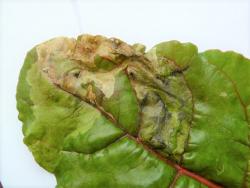 Treat when eggs or first tiny tunnels are noticed. Scout again 7-10 days after treatment to determine if follow-up treatment is needed. Use an adjuvant to improve efficacy unless the product label advises not to. Ensure good coverage of the lower leaf surface.
Treat when eggs or first tiny tunnels are noticed. Scout again 7-10 days after treatment to determine if follow-up treatment is needed. Use an adjuvant to improve efficacy unless the product label advises not to. Ensure good coverage of the lower leaf surface.
Labeled conventional materials include abamectin (e.g. Agri-Mek) and Proclaim (Group 6), Coragen, Exirel, and Verimark (28), Trigard (17), Venom and Platinum (4A), Pounce (3A), and Radiant (5). Of those, only Radiant is labeled for use on beets. Brigade (3A) and Harvanta (28) are also labeled for use on spinach. The diamides (Coragen, Exirel, Verimark, Harvanta) and neonicotinoids (Venom, Platinum) are systemic and some may be applied to transplants or to the soil. Radiant has some translaminar activity, particularly when combined with a penetrating adjuvant, and may be effective against larvae in leaf mines.
The most effective OMRI-listed material is spinosad (e.g. Entrust) applied before egg hatch. Like Radiant, Entrust has some translaminar activity and may be effective against larvae within the leaf. Improved control is achieved by adding a spreader sticker or insecticidal oil e.g. Suffoil or JMS Stylet Oil.
--UMass Vegetable Program
News
MDAR Agricultural Composting Improvement Grant Program Now Taking Applications
This grant program is for purchase of equipment and project expenditures which will enhance the overall management of agricultural composting operations, improve efficiencies, and encourage on-farm compost use.
Applications due August 1, 2024, 4pm
Click here for details on how to apply and COMMBUYS link.
Contact: Sean Bowen, 617-869-7178, Sean.Bowen@mass.gov
May is Mental Health Awareness Month: Check Out MDAR MassGrown Wellness Program
In recognition of May as Mental Health Awareness Month, MDAR is raising awareness of its MassGrown Wellness Program. The program was launched in 2023 to promote mental health and well-being among members of the farming community.
The program’s Peer Support Network connects individuals to like-minded peers who understand the unique challenges of farming. This network is designed to break down the barriers to starting conversations and removing the stigma associated with mental health and wellness. The Peer Support Network is a free, ag-friendly resource for Massachusetts farmers and growers. It is anonymous and virtual so those who seek and receive support can do so confidentially and conveniently.
The MassGrown Wellness Program and Peer Support Network are part of a USDA Farm and Ranch Stress Assistance Network (FRSAN) funded program developed to help address the mental health and well-being of farmers and those that support them in Massachusetts. Farmers can find a Farmer Peer by going to the following link: MassGrown Wellness Peer Support Network.
Events
FDA Webinar on the FSMA Final Rule on Pre-Harvest Agricultural Water
When: Monday, May 20, 2024, 1-2pm
Where: Zoom
Registration: Click here to register.
The U.S. Food & Drug Administration (FDA) will hold an informational webinar on Monday, May 20, 2024, 1-2pm on the recently released Standards for the Growing, Harvesting, Packing, and Holding of Produce for Human Consumption Relating to Agricultural Water (Agricultural Water Final Rule) issued under the FDA Food Safety Modernization Act (FSMA). During the webinar, the FDA will provide an overview of the final rule and answer pre-submitted questions as well as take live questions.
Twilight Meeting at Tangerini's Farm - Millis, MA
When: June 12, 2024, 4-7pm - free childcare available!
Where: Tangerini's Spring Street Farm,139 Spring Street, Millis, MA, 02054
Registration: Free! Please register in advance, for food ordering and childcare purposes. Click here to register.
Join Tangerini Farm, the UMass Extension Vegetable Program and SEMAP for a twilight meeting!
- Steve Chiarizio of Tangerini Farm will describe the new tile drainage system and bioreactor that they installed at the farm last year with the help of Massachusetts FSIG funding. A representative from Alleghany Services, who installed the system, will also be on-hand to answer questions.
- Maria Gannett, UMass Extension Weed Specialist, and Sue Scheufele, UMass Extension Vegetable IPM Specialist, will talk about sweet corn weed and insect pest management options.
Presentations 4-6 pm, followed by a light supper.
Program co-sponsored by UMass Extension and the Southeastern Massachusetts Agricultural Partnership (SEMAP)
1 pesticide recertification credit is available for this program.
Field Walk at Brookfield Farm - Amherst, MA
When: Tuesday, June 25, 2024, 4-7pm
Where: Brookfield Farm, 24 Hulst Rd., Amherst, MA 01002
Registration: Free! Please register in advance, for food ordering purposes. Click here to register.
Join Brookfield Farm, the UMass Extension Vegetable Program and NOFA/Mass for a twilight meeting!
- Kerry and Max Taylor from Brookfield Farm will describe the new well they installed last year that includes a solar pump. The well was installed with support from NRCS.
- Sue Scheufele, UMass Extension Vegetable IPM Specialist, will lead a field walk and pest scouting demonstration.
- Maria Gannett, UMass Extension Weed Specialist, will lead a weed walk and discuss weed ID, organic weed management, and the relationship between weeds and soil health.
Presentations 4-6 pm, followed by a light supper.
1 pesticide recertification credit is available for this program.
This event is supported by the Transition to Organic Partnership Program.
Field Walk at Hannan Healthy Foods - Lincoln, MA
When: Wednesday, July 3, 2024, 4-6pm
Where: Hannan Healthy Foods, 270 South Great Rd., Lincoln, MA 01773. Park in the lot by the farm stand, carpool if possible as space is limited and the stand will be open to customers at this time.
Registration: Free! Please register in advance so we can order enough food. Click here to register.
Join Eastern MA CRAFT, UMass Extension, and NOFA/Mass for a pest walk at Hannan Healthy Foods in Lincoln, MA! We will discuss how to identify and monitor some of the most prolific and problematic pests and diseases ubiquitous to organic production. Scouting and identification are the first steps towards proactive mitigation practices, learn how to see the farm with fresh eyes.
2 pesticide recertification credits are available for this program.
This event is supported by the Transition to Organic Partnership Program.
Field Walk at Astarte Farm - Hadley, MA
When: Tuesday, July 9, 2024, 4-6pm followed by pizza
Where: Astarte Farm, 123 West St., Hadley, MA 01035
Registration: Free! Please register in advance so we can order enough food. Click here to register.
Join Astarte Farm, the UMass Extension Vegetable Program and NOFA/Mass for a twilight meeting!
- Ellen and Dan from Astarte Farm will lead a tour of the farm, highlighting pollinator habitat that they've installed. The habitat was installed with funding from NRCS.
- Hannah Whitehead, UMass Extension Educator, will talk about the benefits of pollinator habitat for organic farmers.
- Sarah Burquest, UMass Lecturer and cut flower farmer, will discuss the flowers that she grows at Astarte.
1 pesticide recertification credit is available for this program.
This event is supported by and MDAR Specialty Crop Grant and the Transition to Organic Partnership Program.
Field Walk at Morning Glory Farm - Edgartown MA
When: Wednesday, July 17, 2024, 6-8pm
Where: Morning Glory Farm, Edgartown, MA
Registration: Free! Please register in advance so we can order enough food. Click here to register.
Join UMass Extension specialists Sue Scheufele and Maria Gannett for a field walk at Morning Glory Farm. We will identify current pest and weed issues in vegetable crops and discuss their management. There will be lots of time for Q&A, discussion, and dinner and refreshments will be provided.
2 pesticide recertification credits are available for this program.
This event is co-sponsored by NOFA/Mass and Martha’s Vineyard Ag Society with support from the Transition to Organic Partnership Program.
Water & Climate Change Twilight Meeting at Bardwell Farm – Hatfield, MA
When: Friday, August 2, 2024, 5-7pm, with dinner and discussion to follow
Where: Bardwell Farm, 49 Main St., Hatfield, MA 01038
Registration: Free! Please register in advance so we can order enough food. Click here to register.
Join UMass Extension and CISA for a climate-themed twilight meeting at Bardwell Farm in Hatfield, MA!
- Lisa McKeag will share findings from her recent water quality survey of farms around MA and discuss potential impacts of weather and climate change on ag water quality.
- Harrison Bardwell will show off his new automated irrigation system, and discuss irrigation practices and funded projects around the farm.
- Sue Scheufele will discuss climate change impacts on vegetable pests including an on-farm trial for managing Phytophthora blight in peppers hosted by Bardwell Farm.
1 pesticide recertification credit is available for this program.
This event is co-sponsored by CISA as part of their Adapting your Farm to Climate Change Series.
Save the Date! UMass Research Farm Field Day
When: August 13, 2024, time TBD
Where: UMass Crop & Livestock Research & Education Farm, 89 River Rd., South Deerfield, MA
Registration: Coming soon!
Come learn about all the research being done by students and faculty across CNS and by UMass Extension on a tour of the farm. Topics include pollinator habitat, bee health and disease ecology, novel cover cropping strategies, intercropping to reduce greenhouse gas emissions, genetic basis of flowering traits in agriculture, and vegetable variety trials including heat-resistant lettuce varieties for summer production.
Twilight Meeting: Climate Impacts on Weed Management and Soil Health
When: Tuesday, October 8, 2024, 4-6pm, with a light supper to follow
Where: UMass Crop & Livestock Research & Education Farm, 89 River Rd., South Deerfield, MA, 01373
Registration: Free! Please register in advance so we can order enough food. Click here to register.
How is climate change affecting our soils? Often, practices like reducing tillage and cover cropping are recommended to improve soil health and resilience to drought and flood—practices that can also affect weed management. UMass Extension Soil Health specialist will discuss general impacts of climate change on soil health and highlight current research on updating recommendations for planting timing and overwintering survival of cover crop species in MA. Maria Gannett, UMass Extension Weeds Specialist, will relate these strategies to how they can impact weed management.
1 pesticide recertification credit is available for this program.
This event is co-sponsored by CISA as part of their Adapting your Farm to Climate Change Series.
Vegetable Notes. Maria Gannett, Genevieve Higgins, Lisa McKeag, Susan Scheufele, Alireza Shokoohi, Hannah Whitehead, co-editors. All photos in this publication are credited to the UMass Extension Vegetable Program unless otherwise noted.
Where trade names or commercial products are used, no company or product endorsement is implied or intended. Always read the label before using any pesticide. The label is the legal document for product use. Disregard any information in this newsletter if it is in conflict with the label.
The University of Massachusetts Extension is an equal opportunity provider and employer, United States Department of Agriculture cooperating. Contact your local Extension office for information on disability accommodations. Contact the State Center Directors Office if you have concerns related to discrimination, 413-545-4800.
